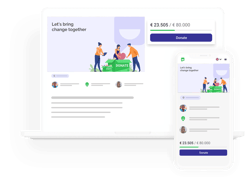Starting a non-profit organisation or setting up a foundation is not an easy task. As with so many things worth doing, setting up a non-profit or foundation requires critical thinking, dedication, patience, and a lot of hard work. While the entire process can be pretty intimidating, tedious, and sometimes overwhelming due to its complexity, a systematic step-by-step approach can contribute to success. We are well aware that setting up a foundation takes courage, so we certainly admire your commitment!
To help you, we’ve put together a detailed guide to the key foundation steps you can follow to start a non-profit or foundation in a systematic, organized, and stress-free way.
Table of Contents
What Is A Non-Profit Organisation?
Non-profit organisations are groups that aim to benefit society as a whole. They can operate in various ways, such as by carrying out community service projects or providing childcare or recycling programs. Unlike for-profit corporations, non-profit groups do not distribute their earnings to their shareholders. Instead, they use their revenues to support their social goals and pay for their operations. They also advocate for their causes and provide social capital.
A non-profit organisation focuses on many social causes like :
- Welfare
- Culture
- Education, Science, and Research
- Nature, environment, and sustainability
- Healthcare
- Animal welfare
- Youth and elderly care
- Development cooperation
- Religion, philosophy, and spirituality
- Promotion of the democratic legal order
- Public housing
- Supporting a public benefit institution
Public charities, foundations, social advocacy groups, and trade organisations are the most common types of non-profit organisations. Some examples include food banks, museums, art groups, amateur sports, colleges, low-income housing organisations, and animal welfare organisations.
Instead of paying dividends, non-profit organisations establish social capital, which is a type of financial benefit that they can give to society. These organisations strive to solve problems and issues that affect humanity in a certain way.
Now that we understand what a non-profit is, it’s time to embark on this journey. Brace yourself!

What Is The Benefit Of Setting Up A Foundation?
Suppose your organisation cannot distinguish itself in any way and cannot offer a clear solution to an existing problem. In that case, it will be challenging to get funding for a foundation to start. Essentially, it will also be harder to get support if you just duplicate existing services rather than improve or add to them in any meaningful way.
Setting up a foundation is not as easy as it sounds. It can be very challenging to start one, and experts say that only around half of all organizations have been around for five years or more. If you are planning to set up a foundation, then here are some steps you can follow to make the process easier.
Step 1
Think about the target demographic/population you want to serve. You don’t need to go into too much detail just yet, but be sure to identify the audience’s needs you hope to serve. Think about your intended solution and whether you add value.
Step 2
Find data about the demographics of people who need your services and also show that that need is not being met.
Step 3
Identify non-profit or for-profit organisations that already meet the same needs or target the population(s) you want to serve.
Step 4
Consider other alternatives to setting up a foundation or starting your own non-profit, joining in some capacity with an existing organisation, becoming a consultant, starting a donor-advised fund, or seeking tax sponsorship.
Step 5
Triple-check with yourself and the others you work with. Think about the following questions:
- With all this in mind, do we still want to set up a foundation?
- Considering all the pros and cons, is starting a foundation or setting up a foundation the best way to fulfil this mission?
- Do we add value by setting up a foundation, and do we have a specific solution for a specific problem?
Professional tip 1: To help you, you can also conduct a non-profit needs assessment on the relevant population.
Professional tip 2: Ensure to save all the qualitative and quantitative data you collect throughout the research process. These will come in handy later on as your “basic data” when you start monitoring and evaluating your organisation’s work in the future.

How Do You Set Up A Foundation?
Your non-profit organisation should be built on a solid foundation and clarity. A clear vision and value ensure a well-run and robust organisation. For a reasonable basis, take the following things with you:
- Choose a name for your non-profit.
- Identify and state the need/problem.
- Devise and provide a solution to that problem.
- Define a population.
- Determine a vision and values.
- Come up with a relevant mission statement.
1. Choosing A Name For Your Non-Profit Organisation
In the beginning, you also need to choose a name for your non-profit organisation. There are many ways you can name your non-profit. However, it is safe to say that you should choose a unique name that is somehow related to the main activities of your non-profit. Because this decision will set the tone and impact your non-profit’s brand for years to come, so it’s wise to take time to think about this decision.
How do you choose a name for a non-profit organisation?
- Try brainstorming with your team or with your friends and acquaintances.
- See which names sound inspiring or which are memorable.
- Keep in mind your non-profit’s mission, what your main activities are, who your members are, or even where you are.
- Make sure your non-profit’s name is easy to pronounce and remember. Use descriptive words, but try not to overdo it or make the name too long. Do not use technical/industry-specific jargon.
- Abbreviations are good if you use them correctly.
Note: It may be a good idea to check the availability of web domains as it may affect the name you choose.
Once you have selected your name, you should check if the name is already a trademark of another company. As mentioned before, to attract funding, you must be able to demonstrate that there is a sufficient need for your organisation’s services and that your organisation is also equipped to meet that need. Once you’ve identified the need, solution, and population (which you probably already did in step 1), now’s the time to turn them into a clear and powerful mission statement.
2. Creating A Great Mission
A good mission is essential. It can help your non-profit further clarify your purpose and can be highly motivating for staff and volunteers. It sends out a powerful message about what you stand for, and when clearly described and communicated, it directs your energy and focus and helps you make decisions later.
We’ve written a whole article on how to write a great mission statement for non-profits, but here are some fundamental guidelines to show you:
- Make sure your non-profit’s mission statement is unambiguous, simple, and easy to understand.
- A well-worded mission statement should also be short and to the point.
- A mission statement should primarily inform others about what you do and guide your team members and stakeholders.
- A good mission statement that welcomes everyone’s input is regularly reviewed and shared with everyone.
- Make sure it’s not a marketing slogan, doesn’t use expert language, and doesn’t contain buzzwords and generalities.
A good mission statement will help you build a solid foundation for developing a plan and guiding you in attracting the right people to your organisation when setting up a foundation.
3. Determine Your Vision And Organisational Values Before You Set Up A Foundation
While your vision may include some elements of your mission, it should be even more progressive. Your vision is the future you want to create; your grand plan – how you are going to change the world. Here are some examples of grand non-profit vision statements:
- Red Cross: Aid to people in need.
- WWF: Supports endangered animals and their habitat.
- Alzheimer Europe: Help cure Alzheimer’s disease.
- KWF: More healing, less cancer, and better quality of life.
- Cordaid: We stand up for people in need.
Your values are ideal qualities and qualities that help you fulfil your mission and realize your vision. The organisational values for a non-profit are the firmest beliefs, which guide an organisation’s actions, unite its employees and define its brand. They are abstract ideas that guide the thinking and actions of the organisation. For instance,
Respect – We treat all people with dignity and respect.
Stewardship – We honour our heritage by being socially, financially, and environmentally responsible.
Ethics – We strive to meet the highest ethical standards.
To learn – We challenge each other to strive for excellence and continuous learning.
Innovation – We embrace continuous improvement, bold creativity, and change.
So don’t skip this step! It may be tempting to skip some of this work because you may think that your initial ideas are enough and that working on ‘’those practicalities’’ should take precedence. But this can come with significant risks because your mission, vision, and values will be the most important for making many important decisions, which will have a long-term impact on your organisation.
4. Prepare A Detailed Business Plan
Some non-profit founders choose to hire or recruit volunteers before setting up a plan, but we recommend going the other way around. Only when you have made a plan can you estimate the income, costs, and talent you need and can afford. Therefore, when you set up a foundation, invest time in advance to develop a detailed plan. Such a plan provides the structure and discipline to consider critically important strategic and operational issues.
Before you start writing your business plan for your non-profit, it’s wise to do some more market research (in addition to the research you’ve already done for your needs analysis and for determining your target audience). Dive deep into your demographics. For example, if you’re starting a non-profit organisation or foundation that focuses on literacy and that you think will address the needs of young people in your area, you obviously need to know how many schools there are in your area, how many families there are in your area or community, and how many young people have access to a computer at home.
An excellent non-profit business plan sets out a roadmap for the next three to five years of your work. Regardless of size or financial status, when you create a business plan for a non-profit, you are essentially creating a blueprint for how your non-profit will run, who is responsible for what, and how you want to achieve your goals. Here are the key building blocks for a non-profit business plan:
-
Founding Foundation Management Summary
This should be the first part of your business plan, but it should be written last. It should describe the mission and purpose of your non-profit, summarize your market analysis (which shows a demonstrable need), and explain how your non-profit will meet that need. Before describing any of your programs or services, write about your mission, vision, and values.
-
Products, Programs, And Services
Use this section to describe in-depth the products and services your non-profit will be offering. Who will benefit from this? What are your outcome-based goals, and how do you plan to achieve them? How do your programs and services create positive change?
-
Marketing Plan
Explain the trends in your market and demonstrate the need for your non-profit’s services. How will you publicize those activities? Which channels will you use for this?
-
Operational Plan
What do your daily activities look like? Determine your organisational structure. When structuring your organisation, determine what each role will accomplish. And where are you going to settle?
-
The Impact Of The Plan
Describe the change you want to bring about. What are the specific goals you want to achieve? How are you going to measure the change you are making? How will you use what you learn and share it with others?
-
Financial Plan
What is your financial status? Include any cash flow statements, balance sheets, and income statements (if applicable). Set a budget. How is the income guaranteed? What are the potential income streams? How much money do you need to get started, and how much do you need to keep up? What start-up costs are there? Are there still gaps?
Read here our article on how to write a solid start non-profit business plan for a foundation.
5. Build A Strong And Motivated Leadership Team
Good people are the most important thing for running a successful non-profit organisation or setting up a foundation. You need to find partners who share your passion for the mission. Creating a trusted leadership structure and network of passionate, committed individuals is the only way to ensure your non-profit thrives.
Let’s look at three key groups of people that are indispensable to any non-profit.
-
Board Members
Hiring great board members is one of the most critical processes for setting up a foundation. Your board is ultimately responsible for regulatory compliance, strategic decision-making, support for day-to-day operations, recruitments, and a wide range of similar tasks. Consider what knowledge, skills, abilities, and other attributes a good candidate would need to be an ideal executive for your non-profit, and which of those attributes are most important to you?
Please note: board members cannot be paid. You must indicate this in your articles of association and 1023 application. A founder can be paid if he acts in a staff role, such as a director or president. If they are employed, they can only sit on the board as a ‘non-voting member.’
-
Personnel
Some of the employees that non-profit organisations usually recruit initially are a membership manager, a communications manager, a fundraising manager, or an event manager.
The roles you choose really depend a lot on your operational plan and the type of non-profit organisation. If one of your main activities is organizing events, then an event manager is a position you should consider hiring. Likewise, if your non-profit is a club or association, a membership manager may be a necessary position to hire.
In contrast to the board and volunteers, employees are usually paid. That’s why you need to determine how much you can spend on salaries. Think of various benefits that you can offer your staff.
To hire the best team, write clear job descriptions with outlined metrics for success, key responsibilities, and key learning/growth paths. Your mission should be embedded everywhere, so you hire team members who are genuinely passionate about the work.
-
Volunteers
Many non-profit organisations rely on their volunteers to run the activities. Consider this carefully before recruiting volunteers:
- How much time do you expect your volunteers to commit to each week?
- How many volunteers do you need to support the daily activities?
- Consider whether your volunteers need special skills, and if so, where can you find them?
- Are you going to train your volunteers? If so, how much time and effort are you willing to invest in the training?
- Will the opportunities for the volunteers be in person or online?
All of these questions will help you create volunteer role descriptions and promote the opportunities. Don’t forget to share your mission with the volunteers and make it easy for them to sign up!
Learn more about recruiting and retaining great volunteers.
Pro Tip: Before you officially hire people (and even if you don’t hire one), your non-profit needs to get an RSIN. You will also need it to open a bank account for your organisation and complete many of the necessary registration forms required by the local government. To request an RSIN, you can visit the website of the Chamber of Commerce.
6. Build Your Identity At A Foundation
Note: You can also do this in Step 2 if it works better for you – right after you define your mission, vision, and values.
Once you have your mission, your vision, and your values, you need to develop strategies that communicate them to the outside world. Internally, it is also essential that everyone understands what your organisation stands for and why. When it comes to goals and priorities, everyone needs to be on the same page to project a consistent brand identity.
Read this article we’ve written for you to learn more about how to follow a brand strategy as a non-profit.
Branding matters
Good non-profit branding helps unite all your stakeholders, help you stand out, get your message across and build your audience’s trust. In addition, it is essential for successful fundraising and increased engagement.
A brand is more than its visual identity: the name, the logo, and the graphic design. A brand is a construction in the minds of those who are aware of it. And brand management is the work of managing all those associations. When building a brand, it is vital to reference your demographics so that you can tailor your communication to their exact needs. Think of an excellent logo for your organisation – simple but compelling, moving and recognizable, memorable, and communicating who you are.
Pro Tip: To help with consistency, create a simple guide for the non-profit’s brand that captures your key design elements, the typography, logo, and other brand elements. Ensure that the manual contains rules for what is and is not allowed when using those elements online and offline. For example, you can make it clear that your logo should not be changed or used on specific backgrounds or in contexts.
7. Legalize Your Non-Profit
Legalizing your non-profit is a multi-step process:
- Choosing a name for your organisation
- Appointing a board
- Determining your legal structure
- Submitting the paperwork
- Applying for tax exemption
- Obtaining the required licences
There are different types of non-profit organisations.
There are also different types of non-profit organisations (for example, trusts, associations, foundations, corporations, and so on), and their structures can vary from state to state. Typically, state law provides specific guidelines on what is required for each designation. Be sure to read the state regulations carefully to get your legal structure right.
You should also consider how those specifics of your structure affect your tax status. When different types of non-profits apply for tax exemption, they must ensure that their way of working is consistent with the tax designation they receive.

8. Ensure Safe Financing When Setting Up A Foundation
For non-profit organisations, identifying funding sources and deciding on a funding model for their organisation can be one of the most challenging tasks. A non-profit with inadequate funding is unlikely to last long enough in the beginning to launch a robust fundraising program.
Subsidies and setting up a foundation
The most common way to secure startup funding for a non-profit is to apply for grants. Grants are usually awarded to a non-profit organisation for a specific program or purpose. A grant provider generally focuses on a specific population, certain types of non-profit organisations, or certain types of support (operational support, capital support, or program development).
While grants can provide you with money more quickly at the beginning than many other sources of funding, applying for them can be very time-consuming. Firstly, it takes time to develop the skills for writing a grant application that brings in grants, then it takes time to write a grant application, and then it can take a while before you see the money in your bank account.
Here are our top tips, and you can read more about them here :
- First, consider whether you can truly meet the grant requirements, whether you have the right employees and skills, and whether you can continue the activities after that.
- Look for funders whose missions and values align with yours.
- Start small to build grant application expertise.
- Research various subsidy options and carefully choose the most suitable one.
- Build relationships and prepare.
- Invest time and resources into writing a great grant application.
Securing some initial funding early, no matter which funding model you later choose for your non-profit, is the best way to begin its mission.

9. Now Start Setting Up A Foundation For The First Activities
Once you’re official, you can start doing the work you’re passionate about. This passion led you through the arduous process of setting up a foundation or a non-profit or setting up a foundation, but you have reached the other side – congratulations! It is now time to start with the activities:
-
Start Building An Extensive Network
Building a professional network for your non-profit can have some great benefits in the beginning. Networking can help increase the visibility of your work, attract new donors, staff, and volunteers, and connect your non-profit with the essential resources it needs to get started.
You may need to connect with other non-profits in your area or non-profits in the broader region with missions similar to yours, with multiple digital outlets, such as blogs or news channels and other relevant media channels.
-
Create A Great Website
If you haven’t already, now is the time to create a website. Keep your website regularly updated with new blog articles, pages, photos, and updates. If you’re interested in starting blogging, we’ve written an article on how to start a successful non-profit website. There are many options to build a website, such as WordPress, Wix, Weebly, and Squarespace, and there are website builders who can build a custom website.
Pages to include on your non-profit website.
- Home page (the main call-to-action on this page, along with news, featured members, upcoming events, and lots of photos);
- ‘About us’ page (your organisation’s story, mission, vision, and values, as well as profiles of the founder and current board members);
- ‘Contact Us’ (with links to how people can reach you, including on social media);
- Donation page (information about donating, donation form to give online);
- ‘Join’ page (volunteer application form, board or staff vacancies, membership program information);
- Sign up for the email list;
- Events (dates, times of your upcoming events, and some of the benefits of participating in one of your events);
- News/blog (updates, articles, knowledge leadership, community engagement, media);
- Sources and references (if applicable);
- For members only (if applicable).
Professional Tip: While an online donation page isn’t the only way to accept donations, it is a critical part of a modern non-profit’s holistic fundraising strategy. Online giving has grown over the years and continues to grow. Unlike many other forms of donating (via a phone call, email, or fundraiser), donation pages are very shareable. This makes them ideal for increasing your reach and, therefore, also for the number of donations.
In addition, donation pages allow you to collect and track data that can inform your fundraising strategy (e.g., the size of the donation, when the donation was made, who donated, how much, how they got to your website, etc.)
Finally, donation pages also make it easy and simple for your donors to give!
-
Create A Marketing And Content Plan
It can be tempting to let your marketing develop organically, but this poses more problems than benefits. Suppose you don’t have a strong marketing strategy early on in developing your non-profit. In that case, you may find yourself constantly dealing with inconsistent and inaccurate public perceptions of your non-profit, difficulty raising funds, and a lot of wasted time and money.
Create a marketing and content plan. Think about how you communicate with your target audience (emails, newspapers, letters, social media, and so on). If you already did this while creating your non-profit business plan, add more details now.
-
Go On Social Media
Social media is free! So, it’s ideal for a new budding non-profit to use it to get its mission across and talk about its work. Share relevant content, tell people about your events, share fundraising initiatives, and send followers to your online donation page. You may also want to consider running an email campaign with regular newsletters, letting your readers know what a great job you are doing. Make sure you collect email addresses and other relevant data correctly from the start.
-
Take Care Of Your People
If you haven’t tackled the hiring and boarding process yet, now is the time. Create job postings that clearly and concisely describe what you’re looking for in employees, and start promoting them. Create volunteer applications, employee manuals, and similar documents for onboard staff and volunteers. Start thinking about your organisational culture. Make sure you follow the human resources best practices.
Foundation tip- Even if you have a team, the work is not done! You also need to make sure that the team you’ve put so much effort into recruiting stays with your organisation. Develop a retention strategy for this. The document does not have to be too detailed. Simply write down the non-profit’s goals, strategies, and activities for the year.
-
Get Started With The Systems
Familiarize yourself with the wide range of systems and tools at your disposal – from fundraising platforms to CRMs to task managers and more. But don’t overdo this, as this can all be overwhelming at first. You don’t need every tool on the planet to do a good job, but investing in a few key tools can get you started.
Here are a few of our favourites:
- Donation software – WhyDonate
- Email software – MailChimp
- CRM – Salesforce
- Communication – Slack
- Analysis – Google Analytics
- Automation – Zapier
- Social Media Management – Buffer
- Design – Canva
- Task Manager – Asana
There are many powerful technologies and tools available, and it can be easy to spend a lot of money on technology that you end up not using. To prevent unexpected high costs, make sure you keep subscriptions manageable.
-
Find An Office
If you don’t have a physical space yet and would like or need it, now is the time to look for it. You will likely need some form of physical presence, such as an office space or service area where volunteers or staff can work. At the very least, you also need a PO box so that you can receive mail. When choosing an office, be realistic about your needs and your budget.
10. How To Receive Donations
There are many financing models to choose from – so it can even cause some confusion. Even then, some non-profits may feel “stuck” and limited in their options. In addition to getting funding at an early stage (usually in the form of grants), it’s wise to set up an online donation platform at the outset as well. You want to avoid losing the initial momentum your non-profit is building, and online fundraising is one of the easiest and fastest ways to raise money.
There is a lot of donation software out there, and if you don’t use one, online fundraising can become quite inefficient or even impossible. It’s important to choose one that’s easy to set up and manage, fits within your budget, and provides a smooth donation experience for your donors. You should look for a sustainable option to not miss out on potential donations at the beginning of your fundraising efforts.
WhyDonate is the most affordable donation platform out there because they charge 0% platform costs on the donations you receive. Our rates are the lowest on the market, and we don’t charge any start-up fees. In addition, our optimized donation form can be easily integrated into your web page so that your donor can pay without leaving your website.
Deciding on a funding model when setting up a foundation or non-profit organisation is crucial. A financing model can combine different financing sources in different “constellations” and proportions. This depends on the nature of the non-profit organisation or foundation you are starting. Below are the different types of financing you could consider.
-
Individual Donations
Individual donors can give one-time or recurring donations. They also give in a variety of ways: online and offline, through events, auctions, scheduled giving, peer-to-peer fundraising, and more.
-
Subsidies
Grants are usually given by the government at the local, state, or federal level, as well as private and public foundations. In general, you do not have to pay back money awarded to you through a subsidy.
-
Corporate Sponsorship
Corporate sponsorship usually comes in three primary forms:
Philanthropic – a non-binding donation, similar to individual giving or event.
Sponsorship – episodic or short-term support, usually event-based.
Induces marketing – longer-term thematic engagement.
Donor matching also exists – when companies match donations made by their employees.
-
Membership Fee
In essence, membership programs ask individuals to contribute something, usually money or time, to an organisation. In return, they become associated with it in some way for a period of time (usually a year) and receive certain benefits.
-
Sale Of Goods And Services
(not applicable to every non-profit organisation) Funding can also come in by selling branded items to generate revenue for your organisation (e.g., t-shirts, tote bags, mugs, cookies) or charging for services (e.g., hospital billing of patients, museums charge entrance fees, theatres sell tickets, social organisations charge dues, colleges require tuition and so on).
-
Donations In Kind
Examples of in-kind donations are food, clothing, and medicines. For example, suppose your organisation wants to bring food and water to areas affected by natural disasters. In that case, it can be beneficial to purchase in-kind supplies such as food, clothing, and water. Each of the funding sources has different opportunities and challenges, and each of them also has its advantages and disadvantages. Regardless of which one you choose, they all require effort and focus.
For more information, check out our article on the top funding sources for non-profit organisations.
Tip from a professional: Donor retention is essential. In a world where fundraisers and non-profits have to work very hard to make their organisations thrive and serve their beneficiaries, donors who have already expressed an interest in your organisation and were willing to give to your cause are invaluable. In addition, recovering lost donors is more cost-effective than acquiring new ones. It can take 18-24 months for non-profits to recoup the amount they spend to attract a new donor, as most donations are generally two to three times less than the marketing/recruitment costs. So when donations come in, take the time to work on a donor retention strategy!
11. Mapping Out The Future
Although setting up a foundation is a complex undertaking, which already involves a lot of work and moving parts, there is something to be said for laying a foundation for the future in these early days.
For example, consider how your workforce and leadership strategies will adapt to your growth. Make strategic plans to officially grow your board, recruit more volunteers, establish membership programs and create new staff positions.
However, first of all, make sure you know everything you need to do to maintain compliance.
These are the basic rules:
- Adhere to your statutes
- Schedule board meetings and also take minutes
- Pay taxes on unrelated activities over $1,000
- Keep all applicable licenses up to date (e.g., CBF hallmark )
- Keep employee, volunteer, and donor information secure at all times
You also need to ensure that you are aligned with the external regulations that affect your industry. When handling personal health information, you need to consider HIPAA compliance, and when processing credit or debit card payments, you need to consider PCI compliance.
If your non-profit works with children, consider checking the criminal records of those who frequently associate with children and meet all standards for storing that information. Contact a copyright expert for your content and make sure that your use of music, video, or other media follows the stated conditions.
During this step, you may also need to think about milestones, which indicate an opportunity to scale your non-profit. It is essential after some time to take some time to think about concrete growth objectives.
Pro Tip: If you haven’t created them during your planning, create a series of key performance indicators and milestones for your non-profit. These provide important performance information that gives you a clear picture of where you are. Without them, it’s hard to evaluate and track progress later on because you have nothing to measure your results against, and you don’t know what “successful” is for your non-profit.
Back To You
Now that many of the fundamental questions about starting a foundation have been covered, you are now ready to follow your growth path and start long-term activities. Remember to keep your mission at the centre of every conversation you have about services, finance, and hiring. Continue to review your business plan, especially the financial data, regularly. Keep an eye on your milestones so you know you’re on track, and readjust if you ever find yourself falling short of your goals. The role of a non-profit organisation has always been to create social change and lead the way to a better world.
You are a pioneer of social change – you can do this!
At WhyDonate, we prioritize solutions that help our non-profits increase their donations. We know that starting financing with a foundation or setting up a foundation is the most important thing. And we know that effective donation forms are an essential part of the sustainability of non-profits. That is why WhyDonate has been developed to meet the exact need by providing a simple and affordable solution and ensuring a hassle-free process for all involved!
And check out our non-profit blog for more free resources.



















